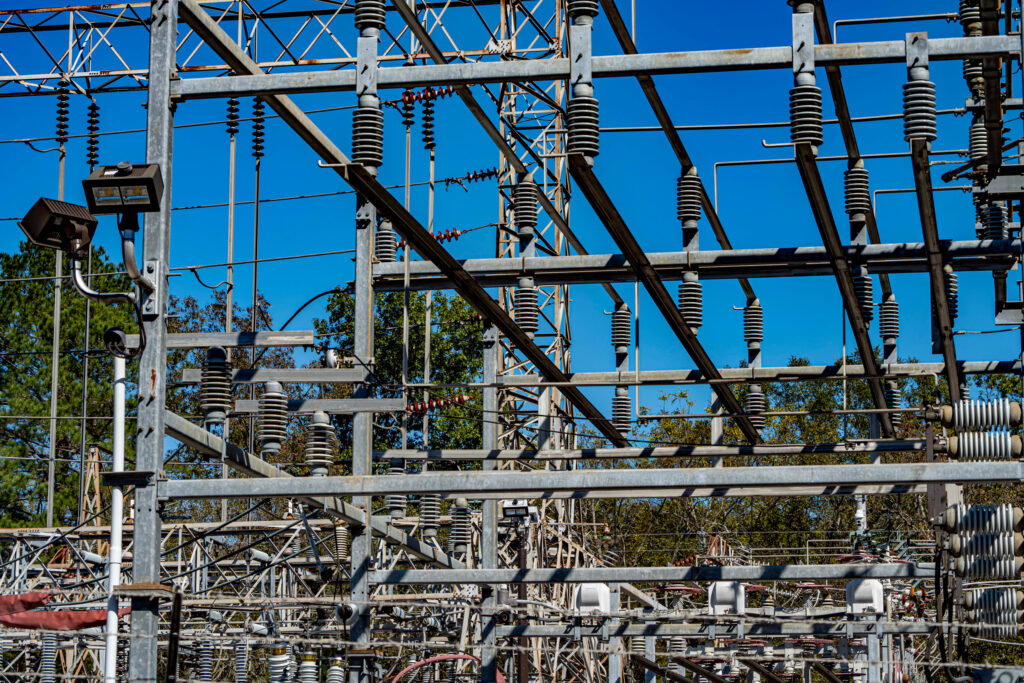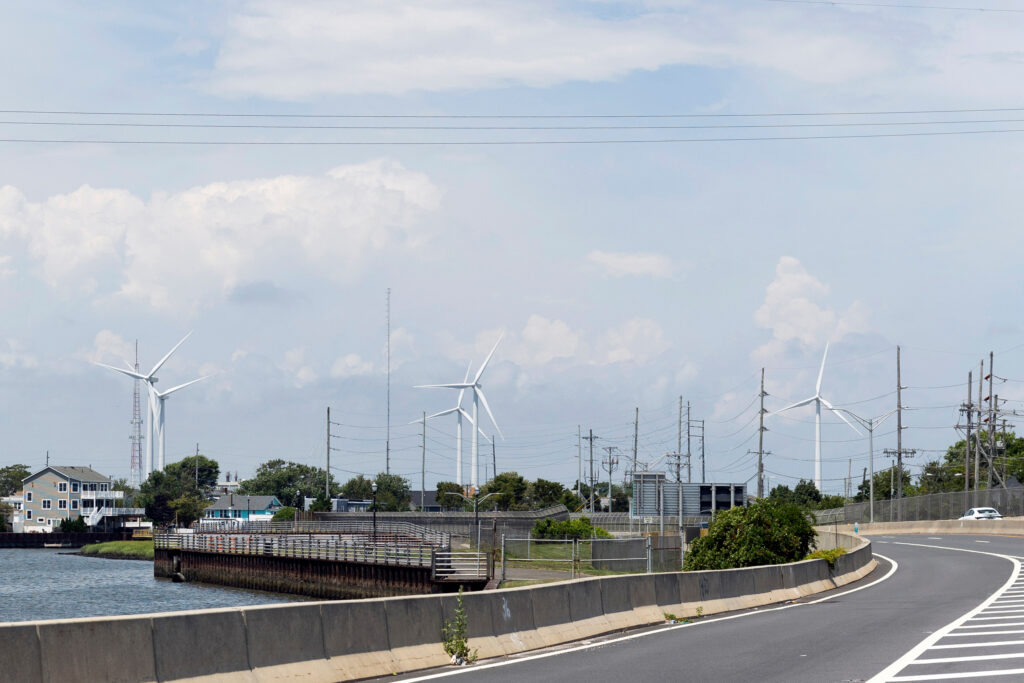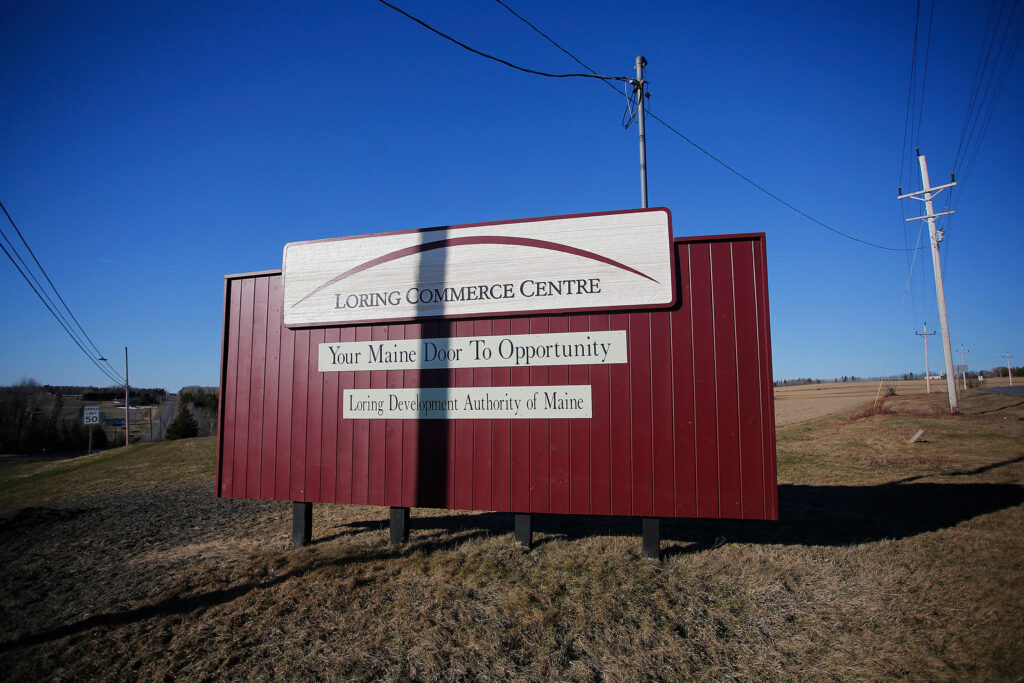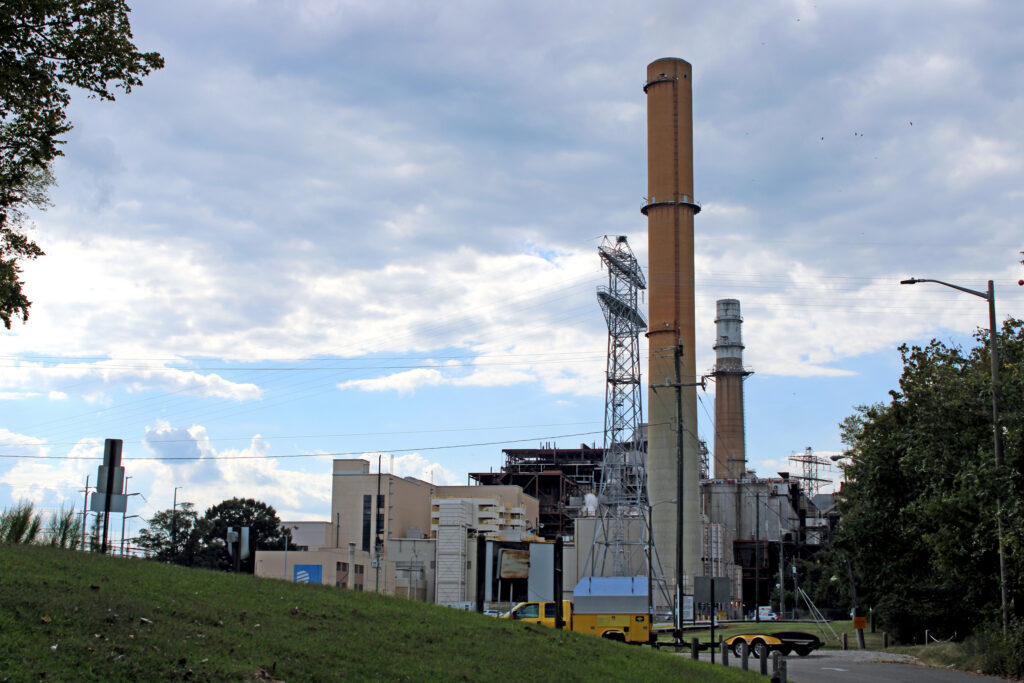The debate that took place in a Washington, D.C., hearing room in June was so filled with energy-industry jargon that most people would not realize they were witnessing a battle over who could own and profit from power plants.
The same fight between utility companies and independent power producers is now happening in statehouses.
Utility companies see the current crisis in the electricity system, driven by rising demand from data centers and high pressure to curb rate increases, as an opportunity. But consumer advocates caution that utilities’ efforts are more a cash grab than a solution.
“We need to plan for contingencies, we need flexibility, we need to plan for redundancies and have all the tools available to us to make sure that when customers turn the lights on, those lights come on,” said Wendy Stark, executive vice president for utilities and chief legal officer for the utility PPL Corp. of Pennsylvania, at the June 4 hearing before the Federal Energy Regulatory Commission.

Stark was talking about changing the law in states that decided decades ago to shift to competitive markets for power plants.
Let’s take a step back, because the concepts discussed at the hearing and in cases before state regulatory commissions are well-understood by the companies involved, but might as well be in a foreign language to most observers.
The first thing to grasp is that more than a dozen states—California and Texas were the largest—decided in the 1990s and 2000s to change the rules for who can own power plants. The states said that utilities would focus on the basics of delivering power and billing, and continue to receive a guaranteed profit for this, while non-utility companies would compete on an open market to see who can produce and sell electricity at the lowest price.
Lawmakers and energy analysts often used the word “deregulation” to describe what was happening, but it would be more accurate to call it a restructuring, since power plants were still subject to federal regulations. The process varied by state, but it often involved the utilities selling their power plants, or spinning off those assets into an affiliated company that no longer had a guaranteed profit.
Meanwhile, most states didn’t move away from traditional regulation, and utilities there continue to have local monopolies over power plants and the electricity delivery system. So now the country has several different regulatory systems existing side by side.
But utilities have long argued that competitive markets are ill-suited to making sure a large region has a reliable supply of electricity at affordable prices. They would like to regain the ability to build power plants in restructured states.
Much of this discussion is happening in the territory served by PJM Interconnection, which runs from New Jersey to Chicago and is the country’s largest grid region. State officials have taken a high interest in PJM, the nonprofit company that manages the grid and market, because of recent spikes in electricity bills.
Utilities are backing legislation in Pennsylvania and New Jersey that would allow them to own power plants. Consumer advocates expect to see a similar proposal in Maryland in 2026. Some of the same discussions are happening in other states, such as Illinois and Ohio, but have gained little traction, based on interviews with people who monitor this lobbying.
Among the losers if utilities get what they want would be independent power producers, which are non-utility companies that own power plants, such as LS Power and Vistra Corp. They would face new competition from utilities that have the security of being able to pass costs directly to consumers.
Utility company officials are arguing that changes in market rules could facilitate the development of renewable energy and help meet state climate goals. But advocates say it’s a mistake to frame this debate solely in terms of its effects on climate change or renewable energy, which they say are secondary to the main reason for this fight: a desire by utilities to maximize profit from the growth of data centers.
“With so much growth on the horizon right now, I’m sure [utilities are] seeing dollar signs, and maybe that’s their job,” said John Howat, senior energy analyst for the National Consumer Law Center. “But that’s not necessarily in the public interest.”
David Lapp, the Maryland People’s Counsel, which is the state government’s consumer advocate on utility issues, said this situation may appear complicated, but it’s simple.
“Utilities see an opportunity to grow their profits by expanding their businesses into generation so they can shift risks on the ratepayers and take advantage of data center load growth,” he said.
Lapp sees no evidence that there would be benefits from allowing utilities to do what they want—no cost savings or improvements to reliability.
But some analysts say that consumer advocates may be missing some nuance. Tyson Slocum, director of the energy program at Public Citizen, argues that states should at least explore whether there is a consumer-friendly way to allow utilities to build power plants in the states where that’s otherwise not allowed.
“There are no easy fixes here,” he said. “But I think it’s important for state regulators and state lawmakers to explore all options on the table for how to keep the lights on in a reliable and affordable way.”
It’s not a coincidence that all the states considering changes have Democratic governors. Slocum said these officials feel an urgency because of a desire to reduce electricity prices and an awareness that the Trump administration is likely to use federal regulation to make competitive energy markets favor fossil fuels even more than they already do.
“Trump is going to turn federal energy regulators at FERC into a policy arm of the White House,” he said.
Remembering the Bad Old Days
For people like Rob Kelter, who has been advocating on utility issues since the mid-1990s, the current discussion reveals that many people don’t remember or understand that today’s system is largely a response to past excesses and failures of utility companies. He is a senior attorney for the Environmental Law & Policy Center, a Chicago-based nonprofit that is active in much of the Midwest.
“There’s a new generation of legislators who in states like Ohio and Pennsylvania and Illinois don’t all remember how bad things were, how high prices were, when we went through restructuring,” he said.
In the mid-1990s, the federal government and many corporations worked to reduce regulations across industries. Enron, which would later gain infamy as a business failure, helped to lead lobbying campaigns in state legislatures to deregulate utilities such as electricity and natural gas.
Utilities had been vertically integrated, with local monopolies over power plants along with the wires and pipelines to deliver resources. Supporters of restructuring pointed to high rates and cost overruns as evidence that the monopoly model led to inefficiency that could be fixed by allowing competition.
By the early 2000s, more than a dozen states had passed some form of electricity deregulation.
The changes meant that utilities needed to move away from direct ownership of power plants, but they retained control of wires, billing and other core functions. Other companies would own power plants and compete on an open market.
Under the new system, power plant owners would assume the risk for their investments. This was in contrast to a vertically integrated system in which utility ratepayers bore the risk.
The shift to deregulation slowed soon after, hurt by the California electricity crisis of 2000 and 2001, in which the state experienced rolling blackouts and high costs. The problems in California stemmed in part from market manipulations by Enron, which was about to collapse following the discovery of accounting fraud.
But states that had changed their rules mostly stuck with the new way of doing things. Competitive markets grew as independent power companies expanded and grid operators refined their processes for overseeing pricing and competition.
Today, 14 states have restructured electricity markets, according to the Energy Information Administration, including California, Connecticut, Delaware, Illinois, Maine, Maryland, Massachusetts, New Hampshire, New Jersey, New York, Ohio, Pennsylvania, Rhode Island and Texas, plus Washington, D.C. Others have more limited forms of these policies, including Michigan, Montana, Nevada, Oregon, Virginia and Washington.


The hearing at FERC headquarters in June was part of a technical conference about the challenges that regional grid managers and utilities face as they try to bring new power plants online. One of the main issues is that data centers are becoming huge consumers of electricity, sometimes outpacing the ability to build new power plants and leading to concerns that a tight supply of electricity will lead to high prices for everyone.
Data centers are “sort of like an accelerant” to existing concerns about having enough power plants to meet consumer demand, Adam Keech, vice president of market design and economics for PJM, said at the hearing.
“We don’t have time to waste,” he said.
On that same panel were representatives from some of the utilities that want to own power plants, and some of the independent power producers that stand to be hurt if states move in this direction.
“If the generators and if the market doesn’t supply more generation, the utility could step in,” said Stark of PPL, which is based in Allentown, Pennsylvania.
On the opposite side are companies such as LS Power of New York, which owns power plants across the country and sells electricity in PJM and other markets.
“Can I just dispel some of the false information that’s being given here?” asked Marji Philips, vice president of wholesale market policy for LS Power. She said her company and other power plant owners were investing heavily in new plants and she rejected the idea that market forces were failing to meet demand.


Changes in state law would allow utilities to enter this market with minimal risk, while the existing players would face high risks and new competitors.
Todd Snitchler, president and CEO of the Electric Power Supply Association, a trade group for independent power producers, said in an email that lawmakers should be wary of “a reversal in policy and a return to the monopoly utility approach for generation.”
On this point, he agrees with Amisha Rai, senior vice president of advocacy at Advanced Energy United, a trade group whose members include many of the leading solar, wind and energy storage companies.
“While growing energy demand is a challenge for all states to tackle, the solution isn’t for states to abandon market competition but rather to continue to press grid operators to make improvements that ensure the lowest cost for ratepayers,” Rai said in a statement.
“States Have an Opportunity”
The discussion at the June hearing hinted at the much larger lobbying effort taking place in statehouses.
In recent earnings conference calls, executives for several large utilities spoke about their hopes that states would change their laws to allow the companies to build and own power plants.
“Despite higher prices, we are not seeing the market respond fast enough,” said Calvin Butler, CEO of Exelon, in a July 31 conference call. His company owns utilities across PJM, including ComEd in Illinois, PECO in Pennsylvania, BGE in Maryland and Atlantic City Electric in New Jersey.
“States have an opportunity to proactively bring control, certainty and cost benefits by pursuing options outside of the capacity market, including regulated generation,” he said.
This story is funded by readers like you.
Our nonprofit newsroom provides award-winning climate coverage free of charge and advertising. We rely on donations from readers like you to keep going. Please donate now to support our work.
Donate Now
FirstEnergy, PPL and PSEG are among the other utilities that have been lobbying in state legislatures on this topic.
The companies are focusing much of their attention on Pennsylvania, and, to a lesser extent, Maryland and New Jersey, based on comments from the companies and other interested parties.
Pennsylvania state Sen. Jarrett Coleman, a Republican, has introduced SB 897, which would allow utilities to build and own power plants in cases where state utility regulators determine that this would lead to cost savings for consumers. The bill is awaiting action in a Senate committee.
“Pennsylvania’s decades-old energy policies need to be updated to address potential energy shortfalls and provide the state with additional tools to help insulate customers from growing price volatility and reliability concerns,” Coleman said in an April memo about the bill.
The Energy & Policy Institute, a utility watchdog nonprofit, has been tracking this process and obtained records of email communications between Pennsylvania Gov. Josh Shapiro’s office and utilities such as Exelon, FirstEnergy and PPL. The messages reveal little about the views of Shapiro, a Democrat, on whether utilities should be allowed to own power plants, but they do show that large and influential companies are trying to nudge him in that direction.
“We look forward to continuing the productive dialogue surrounding resource adequacy in the face of surging electrical demand driven by new data centers, AI technology, electrification and business development,” said John Hawkins, FirstEnergy’s president for Pennsylvania, in a November 2024 email to Shapiro’s staff.
Inside Climate News asked Shapiro’s office whether the governor supports allowing utilities to own power plants.
“Gov. Shapiro’s focus continues to be on lowering costs for Pennsylvanians by expanding energy generation and pushing for PJM reforms that would better support the new power demands,” said Manuel Bonder, a Shapiro spokesman, in an email. “The Shapiro administration has put forward a comprehensive plan that would streamline project permitting, incentivize new energy generation, and reduce power demand through new investments in energy efficiency.”
The comment did not touch on whether utilities should be allowed to own power plants.
In Maryland, Exelon and its local utilities have talked about the need for lawmakers to change rules about who can own power plants. Lapp, the People’s Counsel, expects this to intensify when the Maryland General Assembly reconvenes in January.
In New Jersey, Newark-based PSEG wants to be allowed to build power plants. Ralph LaRosa, the utility’s chairman, president and CEO, said in a conference call this month that the region’s need to rapidly increase the electricity supply “may require the consideration of a new approach to procuring capacity and resource planning.”
A pending proposal, Assembly Bill 5439, would allow utilities to compete for the right to do projects in the state. It’s not clear whether this has a chance of passing.
This bill would not be good for consumers, said Brian Lipman, director for New Jersey’s Division of the Rate Counsel, the state’s consumer advocate on utility issues.
“Competition is good for ratepayers,” he said in an email. “Moreover, utility-owned generation will likely shift the risk of producing generation away from generation developers and onto ratepayers. This means that if something goes wrong (cost overrun, inaccurate load forecast) ratepayers, not the generators, will be liable for the costs of that error.”
About This Story
Perhaps you noticed: This story, like all the news we publish, is free to read. That’s because Inside Climate News is a 501c3 nonprofit organization. We do not charge a subscription fee, lock our news behind a paywall, or clutter our website with ads. We make our news on climate and the environment freely available to you and anyone who wants it.
That’s not all. We also share our news for free with scores of other media organizations around the country. Many of them can’t afford to do environmental journalism of their own. We’ve built bureaus from coast to coast to report local stories, collaborate with local newsrooms and co-publish articles so that this vital work is shared as widely as possible.
Two of us launched ICN in 2007. Six years later we earned a Pulitzer Prize for National Reporting, and now we run the oldest and largest dedicated climate newsroom in the nation. We tell the story in all its complexity. We hold polluters accountable. We expose environmental injustice. We debunk misinformation. We scrutinize solutions and inspire action.
Donations from readers like you fund every aspect of what we do. If you don’t already, will you support our ongoing work, our reporting on the biggest crisis facing our planet, and help us reach even more readers in more places?
Please take a moment to make a tax-deductible donation. Every one of them makes a difference.
Thank you,


















